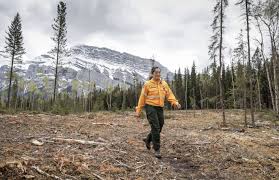Looking out over a budding meadow with blackened tree stumps on the edge of Banff National Park, Cliff White points to a dark thicket of trees where the empty plot ends.
“The next fire in here is going to be incredible,” says the former Parks Canada fire management co-ordinator, standing in the expansive Carrot Creek fire break.
The meadow was shorn more than 20 years ago by Parks Canada to slow future wildfires in their tracks before reaching Banff and Canmore.
But it’s a fraction of the dense, naturally fire-prone forest blanketing the Bow Valley, where fear is growing that a shower of embers, like those that destroyed a third of the structures in Jasper last summer, could hit Alberta’s most popular tourist destination.
The Rockies are facing another year of drought conditions.The snow melted several weeks earlier than normal, and the snowpack is lower than it was in 2023, the year of Canada’s record-breaking wildfires, said John Pomeroy, a hydrologist who lives in Canmore.
“Canmore’s watching with great trepidation,” said Pomeroy, also a university professor.
In the race to mitigate the damage from future fires, stewards of Alberta’s parks have turned to loggers to create fire guards like Carrot Creek. The areas are designed to starve a fire of fuel and create enough empty land for embers to fizzle out on the ground.
This year, Parks Canada hired an Indigenous logging company to raze several hectares of land near Banff. Profits of that timber will be used to maintain the land, said Jane Park, fire and vegetation specialist for Banff National Park.
Each fire break represents the start of a new ecosystem that Parks Canada will need to maintain.“ We can’t just let nature do its thing and just have wildfires kind of go willy-nilly,” said Park, standing among large slash piles in one of Banff’s newest fire breaks.Though hotter and drier summers have triggered the most damaging wildfire seasons in recent years, decades of fire suppression, starting in the early 1900s, have made forests throughout the Rockies thick tinderboxes.Fire is part of the natural life cycle for many of those trees, which carry seeds inside their pine cones that are only released when they’re on fire, Park said.
Prescribed burning, a traditional Indigenous practice, was stopped more than 100 years ago but restarted in the 1980s when Parks Canada discovered it had allowed the forest to grow out of control, Park said.
Anxious Banff gears up for first summer since Jasper wildfire

